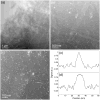Correlative fluorescence microscopy and scanning transmission electron microscopy of quantum-dot-labeled proteins in whole cells in liquid
- PMID: 20550177
- PMCID: PMC2919632
- DOI: 10.1021/nn1010232
Correlative fluorescence microscopy and scanning transmission electron microscopy of quantum-dot-labeled proteins in whole cells in liquid
Abstract
Correlative fluorescence microscopy and transmission electron microscopy (TEM) is a state-of-the-art microscopy methodology to study cellular function, combining the functionality of light microscopy with the high resolution of electron microscopy. However, this technique involves complex sample preparation procedures due to its need for either thin sections or frozen samples for TEM imaging. Here, we introduce a novel correlative approach capable of imaging whole eukaryotic cells in liquid with fluorescence microscopy and with scanning transmission electron microscopy (STEM); there is no additional sample preparation necessary for the electron microscopy. Quantum dots (QDs) were bound to epidermal growth factor (EGF) receptors of COS7 fibroblast cells. Fixed whole cells in saline water were imaged with fluorescence microscopy and subsequently with STEM. The STEM images were correlated with fluorescence images of the same cellular regions. QDs of dimensions 7x12 nm were visible in a 5 microm thick layer of saline water, consistent with calculations. A spatial resolution of 3 nm was achieved on the QDs.
Figures



References
-
- Lippincott-Schwartz J, Snapp E, Kenworthy A. Studying Protein Dynamics in Living Cells. Nature Reviews. 2001;2:444–456. - PubMed
-
- Hell SW. Far-Field Optical Nanoscopy. Science. 2007;316:1153–1158. - PubMed
-
- Leis A, Rockel B, Andrees L, Baumeister W. Visualizing Cells at the Nanoscale. Trends Biochem Sci. 2009;34:60–70. - PubMed
-
- Sun MG, Williams J, Munoz-Pinedo C, Perkins GA, Brown JM, Ellisman MH, Green DR, Frey TG. Correlated Three-Dimensional Light and Electron Microscopy Reveals Transformation of Mitochondria During Apoptosis. Nat Cell Biol. 2007;9:1057–65. - PubMed
Publication types
MeSH terms
Substances
Grants and funding
LinkOut - more resources
Full Text Sources
Other Literature Sources

